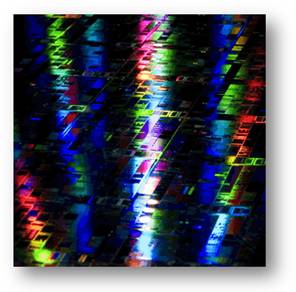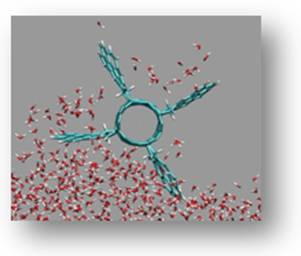Technological change
 In this section we are looking at some other areas where technological change has had an impact on business.
In this section we are looking at some other areas where technological change has had an impact on business.
Change
Change tends to affect business in terms of:
- Products
- Materials
- Processes
- Systems
Let's look at each of these in turn.
Products
The application of science and technology means that new products and services are forever entering the market. The possibility of 'first mover advantage' is a strong motivator for many businesses. Much time and money is spent on developing new ways of reducing the period that passes between the first idea and the actual appearance of the product and advantages that correct technical applications can make to product life cycles. All of us are aware of the digital age, the use of mobile forms of communication and medical advances. It is in these areas that many of the new products will appear.

Consider what goods and services may appear next in:
- the mobile phone market
- the entertainment market
Materials
Adapting new, or previously unused materials can reduce costs, improve quality and boost productivity. Genetically modified (GM) foods are foods derived from genetically modified organisms (GMOs). Genetically modified organisms have had specific changes introduced into their DNA by genetic engineering techniques. There is some controversy about the techniques behind this. Critics object to GM foods on several grounds, including safety issues, ecological concerns, and economic concerns raised by the fact that these organisms are subject to intellectual property law.
Suggested future applications GMOs include drugs in food, such as bananas that produce human vaccines against infectious diseases, metabolically engineered fish that mature more quickly, fruit and nut trees that yield years earlier, foods no longer containing properties associated with common intolerances, and plants that produce new plastics with unique properties.
Nanotechnology: The next industrial revolution
However, even more significant than GM technology is the miniaturisation of the materials we use. You are probably more than familiar with the downsizing of technology. Data memory cards for use in cameras, MP3s etc have becoming increasingly small at the same time that their memory capabilities increase. However, these familiar objects are about to be eclipsed by the developments in nanotechnology - by something we cannot see.

I want to build a billion tiny factories, models of each other, which are manufacturing simultaneously. . . The principles of physics, as far as I can see, do not speak against the possibility of manoeuvring things atom by atom. It is not an attempt to violate any laws; it is something, in principle, that can be done; but in practice, it has not been done because we are too big.
Richard Feynman, Nobel Prize winner in physics
 Nanotechnology is the science of building machines at a subatomic level. When K. Eric Drexler popularized the word 'nanotechnology' in the 1980's, he was talking about building machines on the scale of molecules, a few nanometers wide-motors, robot arms, and even whole computers, far smaller than a cell.
Nanotechnology is the science of building machines at a subatomic level. When K. Eric Drexler popularized the word 'nanotechnology' in the 1980's, he was talking about building machines on the scale of molecules, a few nanometers wide-motors, robot arms, and even whole computers, far smaller than a cell.
This new technology offers huge opportunities for business in the creation of machines and processes beyond our imagination a couple of decades ago. Machines that function at a molecular level, medical applications that are astounding and even solutions to climate change with re-engineering of nature. However, you may be surprised to know that nanotechnology is already in everyday products on sale, such as:
- Sunscreens containing nanoparticles of zinc oxide
- Self-cleaning glass in conservatories using nanoparticles to break down and loosen dirt
- Clothing coated with nanoparticles, give better protection from UV radiation. and help repel water and other materials, making the clothing stain-resistant.
- Scratch-resistant coatings on everything from cars to eyeglass lenses
- Tennis racquets - the VS Nanotube Power racket. Is made of carbon nanotube-infused graphite, meaning the racket is very light, yet many times stronger than steel
If you wish to read more, there is an excellent summary of nanotechnology can be found on the 'howstuffworks' site.

A wonderful animation gallery of nanotechnology machinery can be found here.
For a fascinating discussion of the applications of nanotechnology and the huge potential business opportunities, you may like to watch an extract from the BBC's Visions of the Future series with Dr. Michio Kaku discussing Nanotechnology either from the YouTube site or in the window below.
Processes
Technology has been applied to the ways in which products are designed and manufactured.
Computer-aided design (CAD) employs computer technology for the design of real and virtual objects and in the drafting of technical and engineering drawings, in automotive, shipbuilding, and aerospace industries and industrial and architectural design. CAD techniques are also used in the entertainments industry to produce computer animation for special effects.
CAD is an input into:
Computer-aided manufacturing (CAM), which is the use of computer software to control tools and machinery in manufacturing as well as assisting management systems, transportation and storage. The primary purpose of CAM is to speed up the production process while introducing greater precision in cutting and moulding to minimise waste and reduce production costs.
Systems
These too have been radically transformed by technology. In marketing, the Internet is now a major way of reaching both current and potential customers. Communications are virtually instantaneous to anywhere on the globe. Stock control and financial records can be kept electronically, allowing for easier access and faster response to change.
